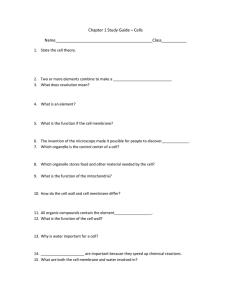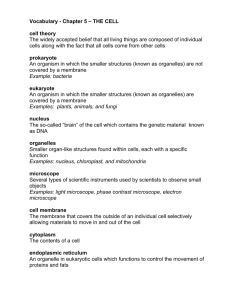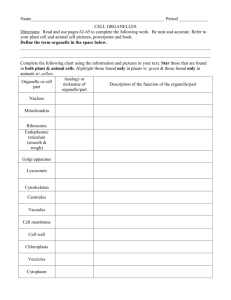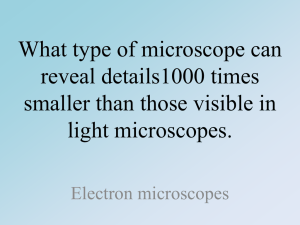Document 10519706
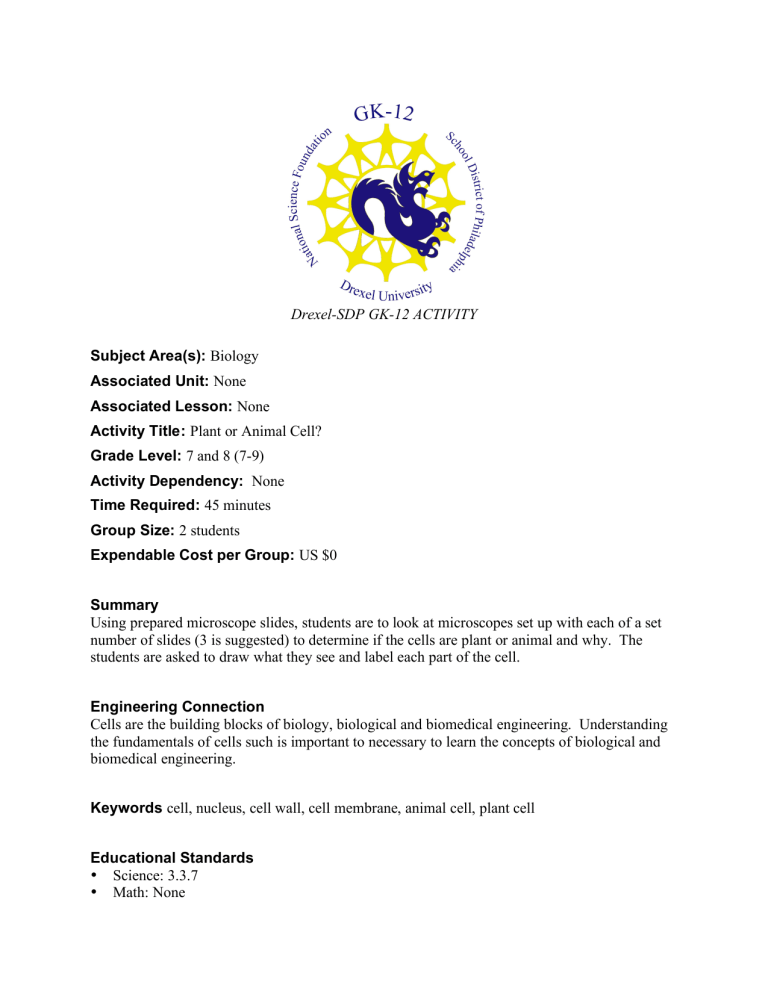
Drexel-SDP GK-12 ACTIVITY
Subject Area(s): Biology
Associated Unit: None
Associated Lesson: None
Activity Title : Plant or Animal Cell?
Grade Level: 7 and 8 (7-9)
Activity Dependency: None
Time Required: 45 minutes
Group Size: 2 students
Expendable Cost per Group: US $0
Summary
Using prepared microscope slides, students are to look at microscopes set up with each of a set number of slides (3 is suggested) to determine if the cells are plant or animal and why. The students are asked to draw what they see and label each part of the cell.
Engineering Connection
Cells are the building blocks of biology, biological and biomedical engineering. Understanding the fundamentals of cells such is important to necessary to learn the concepts of biological and biomedical engineering.
Keywords cell, nucleus, cell wall, cell membrane, animal cell, plant cell
Educational Standards
• Science: 3.3.7
•
Math: None
Learning Objectives
After this lesson, students should be able to:
•
Determine the difference between a plant and animal cell.
•
Be able to use an optical microscope
• Be able to label the parts of a plant and animal cell.
Materials List
Each group needs:
• Worksheet
To share with the entire class:
• Microscopes
• Prepared slides with plant and animal cells.
Introduction / Motivation
Everything around us is made up of cells, of which is either plant or animal (for the most part).
These then become the building blocks of what are now becoming many engineering materials from woods, bamboo, bone, etc… The first part of understanding the properties of these materials and how to use them most effectively is to understand how they work and what they are made up of, so that is what we are determining in this lesson.
Vocabulary / Definitions
Word
Cell wall
Definition
A rigid structure that surrounds the cell membrane and process support to the
Nucleus cell
The organelle that contains the cell’s DNA and is the control center of the cell
Mitochondrion The organelle that breaks down food molecules to make ATP
Lysosome
Endoplasmic reticulum
The organelle that digests food particles, wastes, cell parts, and foreign invaders
The organelle that makes lipids, breaks down drugs and other substances, and packages proteins for Golgi complex
Golgi complex The organelle that processes and transports proteins and other materials out of cell
Ribosome The organelle in which amino acids are hooked together to make proteins
Cell membrane A phospholipids layer that covers a cell’s surface and acts as a barrier between the inside of a cell and the cell’s environment
Chloroplast
Vacuole
The organelle that uses the energy of sunlight to make food
The organelle that stores water and other materials
2
Procedure
Background
There are key differences between the plant and animal cells, such that the animal cells do not have cell walls nor cholorplasts.
Before the Activity
• Print out the handouts for each student
•
Set up the microscopes with the slides and focus on the samples.
With the Students
1.
Give out the copies of the handouts
2.
Break the students into groups of 2
3.
Set each group up and a different microscope and ask them to work through the first part of the worksheet.
4.
Once they finish, have the students rotate to the next microscope to do part two of the worksheet.
5.
Continue with as many iterations as necessary until the worksheet is done.
6.
Collect the in class worksheets from the students when they finish.
Safety Issues
• None
3
Troubleshooting Tips
There are no common issues with this activity.
Assessment
Pre-Activity Assessment
Class Discussion:
• The types of cells should have been covered in class, in particular the key differences between animal and plant cells.
•
Talk about the basics of a microscope and how they work.
Activity Embedded Assessment
Handout: Have the students fill out the handout and review their answers as a measure of the concept comprehension.
Post-Activity Assessment
None
Activity Scaling
• For upper grades, additional concepts can be added such as what exactly are they looking at.
References http://summit.k12.co.us/schools/shs/computer/tkelley/plntcell.jpg
Owner
Drexel University GK-12 Program
Contributors
Valerie R. Binetti, MSE Department, Drexel University
Copyright
Copyright 2008 Drexel University GK-12 Program. Reproduction permission is granted for nonprofit educational use.
4
Name ____________________________________
Date _____________
Microscope Fun!
Draw what you see on microscope #1, make sure you label your drawing with the parts of the cell that you have learned:
Is it a plant or animal? Why?
Draw what you see on microscope #2, make sure you label your drawing with the parts of the cell that you have learned:
Is it a plant or animal? Why?
Draw what you see on microscope #3, make sure you label your drawing with the parts of the cell that you have learned:
Is it a plant or animal? Why?
5



